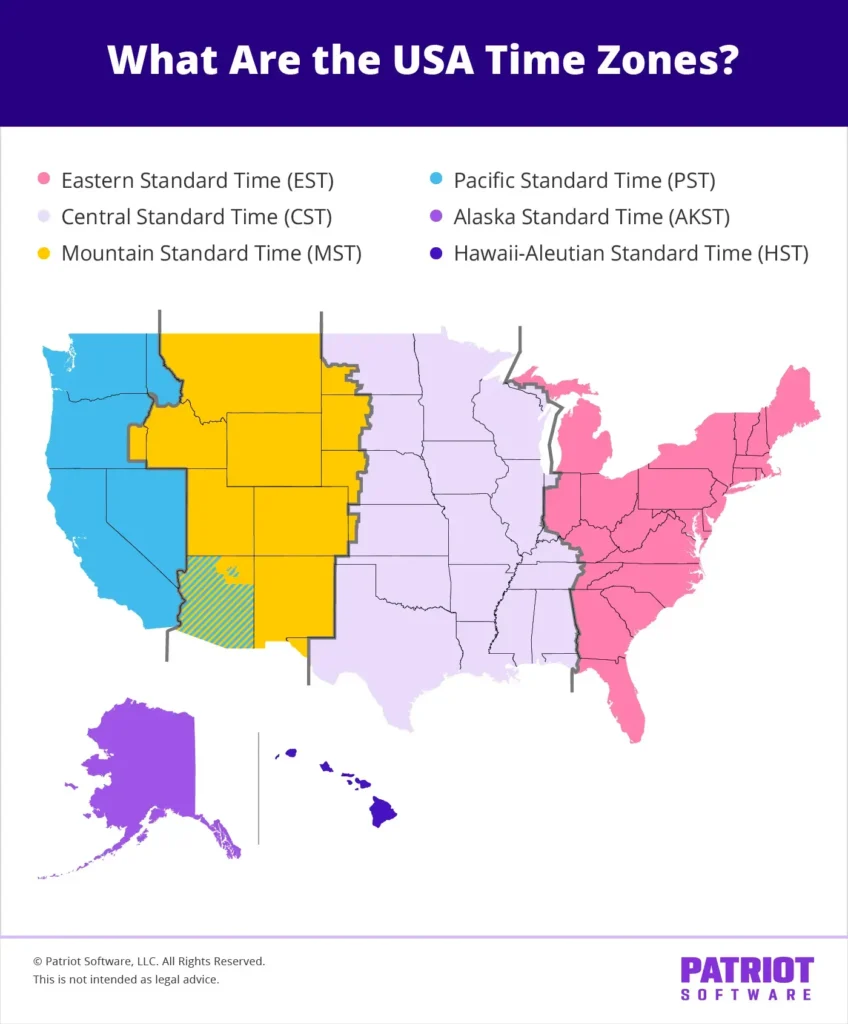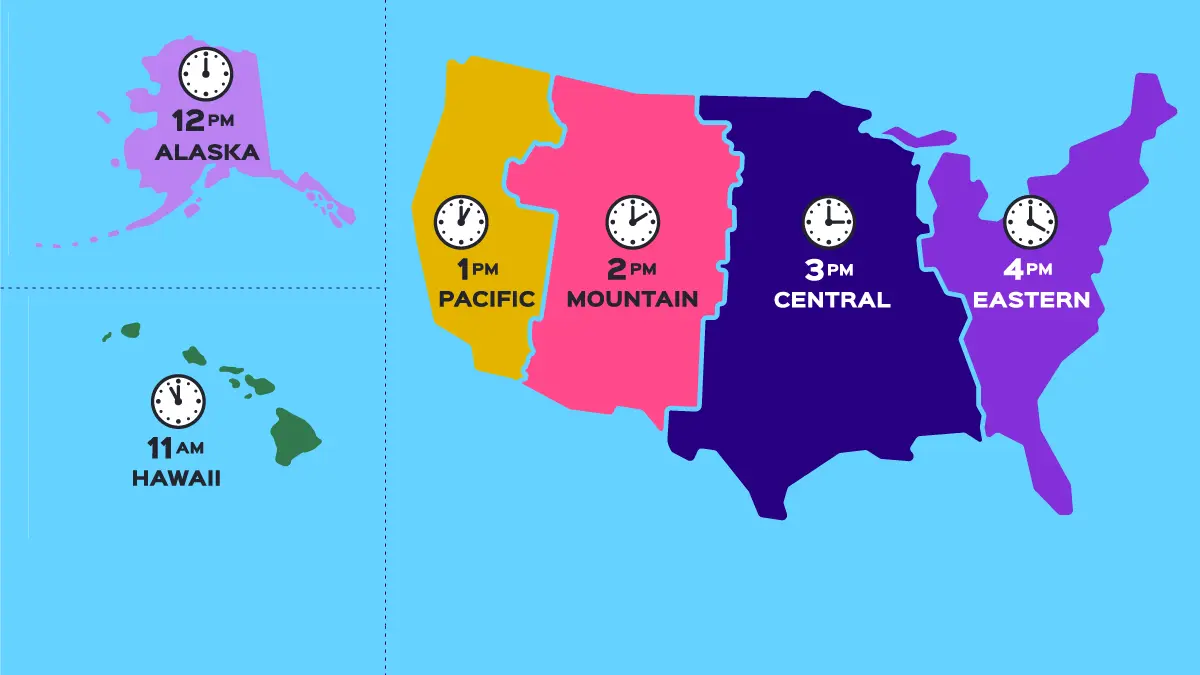Scoot over, Zoom fatigue. There’s a new sheriff in town: time zone fatigue. If you have one employee working in California, another in Wisconsin, and another in Maine, you’re probably already familiar with the condition. To get through the confusion, you need a cheat sheet to understand the different time zones in the USA. And, voila! It has arrived.
Read on to learn why time zones matter in business, what the different time zones spanning the states are, and how to handle time zone differences.
Why do time zones matter in business?
In this day and age, everyone is interconnected. And with many businesses nationwide (and globally) working and operating remotely, juggling multiple time zones is common.
You may work with the following parties across different time zones:
- Employees
- Vendors
- Business partners
- Customers
Whether you’re calling to place an order from a vendor or scheduling a meeting with a remote team, time zones matter.
What are the time zones in the USA?
There are several different time zones in the United States. Take a look at the six zones all 50 states and D.C. could fall under, along with an example of the time difference for each:
- Eastern Standard Time (EST) | 2 p.m.
- Central Standard Time (CST) | 1 p.m.
- Mountain Standard Time (MST) | 12 p.m.
- Pacific Standard Time (PST) | 11 a.m.
- Alaska Standard Time (AKST) | 10 a.m.
- Hawaii-Aleutian Standard Time (HST) | 8 a.m.
Most states also follow daylight saving time (DST), which can throw a wrench in your ability to keep up with different time zones.

What to know about daylight saving time
Daylight saving time is the practice of changing the clocks by one hour in the spring and the fall—springing forward and falling back. In the spring, the clocks go forward (1 p.m. becomes 2 p.m.). In the fall, the clocks go backward (2 p.m. becomes 1 p.m.).
Daylight saving time begins on the second Sunday in March and ends on the first Sunday in November. In total, DST lasts 34 weeks. The purpose is to increase daylight hours so that darkness falls later during the summer months.
But, not all states follow daylight saving time. Officially, Arizona (excluding Navajo Nation) and Hawaii do not observe DST. Several other states that do follow DST have introduced legislation to end the practice of changing clocks.
Not to mention, the U.S. Senate unanimously passed a bill to make daylight savings time permanent in March 2022. If it passes in the House and is signed into law by the president, daylight saving time would be permanent. The bill would also allow Arizona and Hawaii to remain on standard time.
Let’s take a look at an example of how DST currently impacts time zone differences. During daylight savings time in Ohio, Ohio is three hours ahead of Arizona. But when Ohio falls back an hour in November, there’s only a two-hour time difference between Ohio and Arizona since Arizona doesn’t follow DST. So although Arizona is on MST and Ohio is on EST (spoiler!), Arizona is three hours behind during DST.
Want to impress your friends at a dinner party?
Get the latest small business news delivered straight to your inbox.
Subscribe to Email ListWhich states are in which time zones? 2 Charts to use
Want to see which states are in which time zones? We’ve included two charts, depending on what you need. Use Chart 1 to see states categorized by time zone. Use Chart 2 to see states categorized alphabetically.
Heads up! If you do work internationally, make sure to understand global time zones, too.
Chart 1: Time zone
Check out our time zone chart. Remember that some states have two time zones, depending on the county or town (indicated with an *).
| Eastern Standard Time | Central Standard Time | Mountain Standard Time | Pacific Standard Time | Alaska Standard Time | Hawaii-Aleutian Standard Time |
|---|---|---|---|---|---|
| Connecticut | Alabama | Arizona | California | Alaska | Hawaii |
| Delaware | Arkansas | Colorado | Idaho* | ||
| D.C. | Florida* | Idaho* | Nevada* | ||
| Florida* | Illinois | Kansas* | Oregon* | ||
| Georgia | Indiana* | Montana | Washington | ||
| Indiana* | Iowa | Nebraska* | |||
| Kentucky* | Kansas* | Nevada* | |||
| Maine | Kentucky* | New Mexico | |||
| Maryland | Louisiana | North Dakota* | |||
| Massachusetts | Michigan* | Oregon* | |||
| Michigan* | Minnesota | South Dakota* | |||
| New Hampshire | Mississippi | Texas* | |||
| New Jersey | Missouri | Utah | |||
| New York | Nebraska* | Wyoming | |||
| North Carolina | North Dakota* | ||||
| Ohio | Oklahoma | ||||
| Pennsylvania | South Dakota* | ||||
| South Carolina | Tennessee* | ||||
| Tennessee* | Texas* | ||||
| Vermont | Wisconsin | ||||
| Virginia | |||||
| West Virginia |
Chart 2: Alphabetical
Want to find your state and see its time zone? Use our state chart below, organized alphabetically. Again, some states use multiple time zones, depending on the area.
| State | Time Zone(s) |
|---|---|
| Alabama | Central Standard Time |
| Alaska | Alaska Standard Time |
| Arizona | Mountain Standard Time |
| Arkansas | Central Standard Time |
| California | Pacific Standard Time |
| Colorado | Mountain Standard Time |
| Connecticut | Eastern Standard Time |
| Delaware | Eastern Standard Time |
| D.C. | Eastern Standard Time |
| Florida | Eastern Standard Time, Central Standard Time |
| Georgia | Eastern Standard Time |
| Hawaii | Hawaii-Aleutian Standard Time |
| Idaho | Mountain Standard Time, Pacific Standard Time |
| Illinois | Central Standard Time |
| Indiana | Eastern Standard Time, Central Standard Time |
| Iowa | Central Standard Time |
| Kansas | Central Standard Time, Mountain Standard Time |
| Kentucky | Central Standard Time, Eastern Standard Time |
| Louisiana | Central Standard Time |
| Maine | Eastern Standard Time |
| Maryland | Eastern Standard Time |
| Massachusetts | Eastern Standard Time |
| Michigan | Eastern Standard Time, Central Standard Time |
| Minnesota | Central Standard Time |
| Mississippi | Central Standard Time |
| Missouri | Central Standard Time |
| Montana | Mountain Standard Time |
| Nebraska | Central Standard Time, Mountain Standard Time |
| Nevada | Pacific Standard Time, Mountain Standard Time |
| New Hampshire | Eastern Standard Time |
| New Jersey | Eastern Standard Time |
| New Mexico | Mountain Standard Time |
| New York | Eastern Standard Time |
| North Carolina | Eastern Standard Time |
| North Dakota | Central Standard Time, Mountain Standard Time |
| Ohio | Eastern Standard Time |
| Oklahoma | Central Standard Time |
| Oregon | Pacific Standard Time, Mountain Standard Time |
| Pennsylvania | Eastern Standard Time |
| Rhode Island | Eastern Standard Time |
| South Carolina | Eastern Standard Time |
| South Dakota | Central Standard Time, Mountain Standard Time |
| Tennessee | Central Standard Time, Eastern Standard Time |
| Texas | Central Standard Time, Mountain Standard Time |
| Utah | Mountain Standard Time |
| Vermont | Eastern Standard Time |
| Virginia | Eastern Standard Time |
| Washington | Pacific Standard Time |
| West Virginia | Eastern Standard Time |
| Wisconsin | Central Standard Time |
| Wyoming | Mountain Standard Time |
Tips for handling different time zones
There may be times when working with a vendor or customer in a different time zone impacts your day … like if you go to place an order and they’re already closed. Or if you tell a customer you’ll call them at 5 p.m. and you’re two hours behind them.
But, the most common situation you may face with time zone confusion is among your team. According to Gallup, 45% of full-time U.S. employees work from home. And if you let employees work anywhere in the country, their time zones may get a little tricky to juggle.
Take a look at the following tips to help you handle different time zones with ease.
1. Use time and attendance software
Need an easier way to track employee hours across different time zones? Use time and attendance software with a time zone setting.
Employees can enter their in and out times according to their time zone, eliminating confusion and miscommunication for both employers and employees.
2. Be clear about the time zone you’re talking about
“Let’s meet at 1 p.m.” Is that 1 p.m. my time … or yours? If you have employees (or vendors, etc.) working across different time zones, simply saying a time may cause confusion.
To clear the air, communicate which time zone you’re referencing. If possible, you can detail the different times for each party. For example, you may say something like “1 p.m. EST, which would be 12 p.m. CST and 10 a.m. PST.”
3. Use consistency when scheduling meetings
Consider setting up meetings for the same time to provide consistency among employees, customers, vendors, etc.
If employees work varying schedules, schedule meetings during times when all employees are active.
4. Take advantage of tools
Consider taking advantage of the following to help you stay organized and on top of deadlines when working with people in different time zones:
- Project management tools (e.g., Jira)
- Collaboration tools (e.g., Google Workspace)
- Communication tools (e.g., Slack)
Some tools, like Slack, alert you of someone else’s time zone if you send a message early in the morning or late in the evening for them.
Keeping ahead of time zone differences
Effectively manage the difference between time zones to avoid miscommunication blunders with employees, vendors, and customers.
Whether you’re scheduling meetings, placing orders, or planning projects, keep the following time zone tips in mind:
- Understand the different time zones in the U.S. (or beyond if you work internationally)
- Make sure all parties know what time zone you’re talking about
- Take advantage of tools to help you work with people in different time zones
This article has been updated from its original publication date of September 23, 2022.
This is not intended as legal advice; for more information, please click here.



